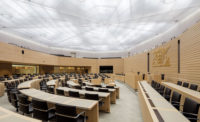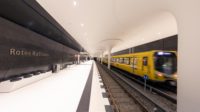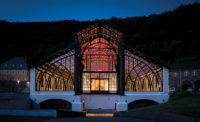Few would pick a daylight-deprived basement as an ideal setting for a cafeteria. Yet, thanks to an imaginative scheme by the Frankfurt-based firm ttsp hwp seidel with lighting design by Licht Kunst Licht (LKL), employees at the HSBC Global Asset Management headquarters in Düsseldorf are transported to the Rhine River while a soothing circadian-rhythm-based illumination program supports their internal biological clocks.
Additional Content:
Jump to credits & specifications
The company’s 5,000-square-foot cafeteria was a relic from the 1970s, when the building by HPP Architekten was built. In addition to a much-needed interior update, the $15.4 million modernization project also addressed the installation of 21st-century HVAC and acoustical systems, as well as kitchen, safety, and infrastructural upgrades.
Strict criteria from the local government specified the injection of daylight into the windowless space. However, structural restrictions to the building’s polished red stone facade—which is protected—limited openings to a tiny light well and a few small windows. “We did calculations and realized there just couldn’t be much daylight at all,” explains LKL lighting designer Isabel Sternkopf.
As an alternative, the design team proposed the installation of an artificial-window wall backed by a photo panorama that would span the rear of the canteen. The scale of the image would mimic a view one might see from a ground-level space. An “intelligent” human-centric lighting (HCL) control system would respond to the color, direction, and intensity of the actual daylight outside to augment the illusion. When the authorities learned this solution would infuse abundant light into the underground facility and be just as beneficial for employees than more intrusive and expensive interventions, they gave it a go.
Visible throughout the dining and self-serve areas, the ½-inch-thick, 69-foot-long, 9-foot-high, floor-to-ceiling window showcases a work from Das Rheinprojekt, a series by artist Stephan Kaluza, who traversed the 766 miles of the Rhine, documenting his journey with a camera every few minutes. Applied to an existing concrete wall, it depicts the river flowing in the same direction as Düsseldorf’s own stretch of the Rhine, a seven-minute walk away.
The photograph—printed on pleated plasterboard for depth and richness—is illuminated from above and below. Contiguous, 59-inch lengths of tunable-white, ceiling-mounted LED strips, sandwiched between the glass and the image, gradually shift from a 2700 Kelvin (K) in the morning up to a cool 6000K at midday and back down to warmer hues in the evening. Similar floor-mounted RGBW LED strips allow for the grazing of light upwards over the scene to highlight and enhance its texture and provide the burnt-orange hues that the controlled system will cycle through at sunrise and sunset.
Project architect Tanja Nopens describes the space as “more restaurant than canteen,” with a buffet and three dining areas, all with custom solid oak tables and black-painted seats. As in a restaurant, the lighting is inviting. Fast, “on-the-go” bar-height tables are lit by cylindrical, powder-coated aluminum 2700K LED pendants that blend into a newly exposed ceiling, painted white to camouflage the HVAC system. Brass Alvar Aalto pendants offer a shiny jolt of hospitality to this casual spot.
A suspended black-painted ceiling above the buffet houses LED downlights specified by Sternkopf “for a high color-rendering index that makes food look tasty.” Some of these are fixed at 2700K, while others are tunable and programmed to correspond to the changing nature-like hues of the light wall. The circadian-rhythm-sensitive lighting and all the other luminaires are programmed together to create realistic atmospheres that change automatically throughout the day, as they would in a daylit room reinforced by a lighting system.
In keeping with the restaurant design language, the artist Kaluza was commissioned to create an illuminated installation over the central dining area. His lattice-like work, comprising 10 black powder-coated aluminum beams ranging from 18 to 38 feet long, houses 55 LED spots that provide an intimate 2700K glow.
The most dramatic dining area flanks the scenic light wall. Here, discreet matte-black aluminum 2700K LED pendants drop over tables. The pendants, which are so lean they don’t obstruct, are assisted by round, adjustable 2700K pinhole spots in the ceiling. The success of this ingenious trompe l’oeil scheme, as with a real waterfront café, is clear: the prime “riverfront” seats are the first to go at lunchtime.
CreditsArchitect: ttsp hwp seidel Planungsgesellschaft—Tanja Nopens, project architect; Isabelle Oberle, Jo Meyer, design team
Lighting designer: Licht Kunst Licht—Andreas Schulz, principal; Isabel Sternkopf, project designer
Engineers: Ingenieurbüro Heiming, Energie- und Gebäudetechnik (electrical) |
SpecificationsLighting iGuzzini (window wall, downlights); XAL, Artek (pendants); Soraa (grid module spotlights) |










Post a comment to this article
Report Abusive Comment